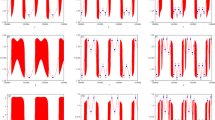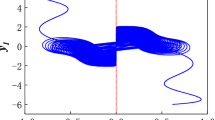Abstract
This paper examines a spike-adding bifurcation phenomenon whereby small-amplitude canard cycles transition into large-amplitude bursting oscillations along a single continuous branch in parameter space. We consider a class of three-dimensional singularly perturbed ODEs with two fast variables and one slow variable and singular perturbation parameter \(\varepsilon \ll 1 \) under general assumptions which guarantee such a transition occurs. The primary ingredients include a cubic critical manifold and a saddle homoclinic bifurcation within the associated layer problem. The continuous transition from canard cycles to N-spike bursting oscillations up to \(N\sim {\mathcal {O}}(1/\varepsilon )\) spikes occurs upon varying a single bifurcation parameter on an exponentially thin interval. We construct this transition rigorously using geometric singular perturbation theory; critical to understanding this transition are the existence of canard orbits and slow passage through the saddle homoclinic bifurcation, which are analyzed in detail.


















Similar content being viewed by others
References
Al-Naimee, K., Marino, F., Ciszak, M., Meucci, R., Arecchi, F.T.: Chaotic spiking and incomplete homoclinic scenarios in semiconductor lasers with optoelectronic feedback. New J. Phys. 11(7), 073022 (2009)
Carter, P., Sandstede, B.: Fast pulses with oscillatory tails in the FitzHugh–Nagumo system. SIAM J. Math. Anal. 47(5), 3393–3441 (2015)
Carter, P., Sandstede, B.: Unpeeling a homoclinic banana in the FitzHugh–Nagumo system. SIAM J. Appl. Dyn. Syst. 17(1), 236–349 (2018)
Chay, T.R., Keizer, J.: Minimal model for membrane oscillations in the pancreatic beta-cell. Biophys. J. 42(2), 181–189 (1983)
Deng, B.: Homoclinic bifurcations with nonhyperbolic equilibria. SIAM J. Math. Anal. 21(3), 693–720 (1990)
Desroches, M., Kaper, T.J., Krupa, M.: Mixed-mode bursting oscillations: dynamics created by a slow passage through spike-adding canard explosion in a square-wave burster. Chaos 23(4), 046106 (2013)
Desroches, M., Fernández-García, S., Krupa, M.: Canards in a minimal piecewise-linear square-wave burster. Chaos 26(7), 073111 (2016)
Desroches, M., Krupa, M., Rodrigues, S.: Spike-adding in parabolic bursters: the role of folded-saddle canards. Physica D 331, 58–70 (2016)
Dumortier, F., Roussarie, R.H.: Canard cycles and center manifolds, volume 577. American Mathematical Soc (1996)
Eckhaus, W.: Relaxation oscillations including a standard chase on french ducks. In: Asymptotic Analysis II, pp. 449–497. Springer (1983)
Fenichel, N.: Persistence and smoothness of invariant manifolds for flows. Indiana Univ. Math. J. 21(3), 193–226 (1971)
Fenichel, N.: Geometric singular perturbation theory for ordinary differential equations. J. Differ. Equ. 31(1), 53–98 (1979)
Guckenheimer, J., Kuehn, C.: Computing slow manifolds of saddle type. SIAM J. Appl. Dyn. Syst. 8(3), 854–879 (2009)
Hindmarsh, J.L., Rose, R.M.: A model of the nerve impulse using two first-order differential equations. Nature 296(5853), 162 (1982)
Hindmarsh, J.L., Rose, R.M.: A model of neuronal bursting using three coupled first order differential equations. Proc. R. Soc. Lond. B 221(1222), 87–102 (1984)
Homburg, A.J., Sandstede, B.: Homoclinic and heteroclinic bifurcations in vector fields. Handb. Dyn. Syst. 3, 379–524 (2010)
Kinney, W.M.: An application of Conley index techniques to a model of bursting in excitable membranes. J. Differ. Equ. 162(2), 451–472 (2000)
Kinney, W.M.: Applying the Conley index to fast-slow systems with one slow variable and an attractor. Rocky Mt. J. Math. 38(4), 1177–1214 (2008)
Krupa, M., Sandstede, B., Szmolyan, P.: Fast and slow waves in the FitzHugh–Nagumo equation. J. Differ. Equ. 133(1), 49–97 (1997)
Krupa, M., Szmolyan, P.: Extending geometric singular perturbation theory to nonhyperbolic points–fold and canard points in two dimensions. SIAM J. Math. Anal. 33(2), 286–314 (2001)
Krupa, M., Szmolyan, P.: Relaxation oscillation and canard explosion. J. Differ. Equ. 174(2), 312–368 (2001)
Lee, E., Terman, D.: Uniqueness and stability of periodic bursting solutions. J. Differ. Equ. 158(1), 48–78 (1999)
Lin, X.-B.: Using Melnikov’s method to solve Silnikov’s problems. Proc. R. Soc. Edinb. Sect. A: Math. 116(3–4), 295–325 (1990)
Linaro, D., Champneys, A., Desroches, M., Storace, M.: Codimension-two homoclinic bifurcations underlying spike adding in the Hindmarsh–Rose burster. SIAM J. Appl. Dyn. Syst. 11(3), 939–962 (2012)
Morris, C., Lecar, H.: Voltage oscillations in the barnacle giant muscle fiber. Biophys. J. 35(1), 193–213 (1981)
Nowacki, J., Osinga, H.M., Tsaneva-Atanasova, K.: Dynamical systems analysis of spike-adding mechanisms in transient bursts. J. Math. Neurosci. 2(1), 1–28 (2012)
Osinga, H.M., Tsaneva-Atanasova, K.T.: Dynamics of plateau bursting depending on the location of its equilibrium. J. Neuroendocrinol. 22(12), 1301–1314 (2010)
Plant, R.E., Kim, M.: On the mechanism underlying bursting in the Aplysia abdominal ganglion R15 cell. Math. Biosci. 26(3–4), 357–375 (1975)
Rinzel, J.: Bursting oscillations in an excitable membrane model. In: Ordinary and partial differential equations, pp. 304–316. Springer (1985)
Rinzel, J.: A formal classification of bursting mechanisms in excitable systems. In: Mathematical Topics in Population Biology, Morphogenesis and Neurosciences, pp. 267–281. Springer (1987)
Rinzel, J., Troy, W.C.: Bursting phenomena in a simplified oregonator flow system model. J. Chem. Phys. 76(4), 1775–1789 (1982)
Rinzel, J., Ermentrout, G.B.: Analysis of neural excitability and oscillations. Methods Neuronal. Model. 135–169 (1989)
Ruschel, S., Yanchuk, S.: Chaotic bursting in semiconductor lasers. Chaos Interdiscip. J. Nonlinear Sci. 27(11), 114313 (2017)
Schecter, S.: Exchange lemmas 1: Deng’s lemma. J. Differ. Equ. 245(2), 392–410 (2008)
Schecter, S.: Exchange lemmas 2: general exchange lemma. J. Differ. Equ. 245(2), 411–441 (2008)
Terman, D.: Chaotic spikes arising from a model of bursting in excitable membranes. SIAM J. Appl. Math. 51(5), 1418–1450 (1991)
Terman, D.: The transition from bursting to continuous spiking in excitable membrane models. J. Nonlinear Sci. 2(2), 135–182 (1992)
Tsaneva-Atanasova, K., Osinga, H.M., Rieß, T., Sherman, A.: Full system bifurcation analysis of endocrine bursting models. J. Theor. Biol. 264(4), 1133–1146 (2010)
Acknowledgements
The author gratefully acknowledges support through NSF Grant DMS-2016216 (formerly DMS-1815315).
Author information
Authors and Affiliations
Corresponding author
Additional information
Communicated by Paul Newton.
Publisher's Note
Springer Nature remains neutral with regard to jurisdictional claims in published maps and institutional affiliations.
A Estimates Near the Saddle Homoclinic Point
A Estimates Near the Saddle Homoclinic Point
In this section, we present a proof of Lemma 3.11. We first quote the following result regarding the nature of solutions to the boundary value problem with entry/exit conditions in the sections \( \Sigma ^\mathrm {h}_A, \Sigma ^\mathrm {h}_B\).
Proposition A.1
(Schecter 2008a, Theorem 2.1) Fix \(\Delta >0\) small. There exists \(K_0,\eta >0\) such that the following holds. For any sufficiently small \(\varepsilon >0\), any \(T>0\) and any \(|Y^*|\le \delta _Y\), there exists a solution \((A,B,Y)(\xi ;Y^*,T)\) to (3.32) with \((A,B,Y)(0)\in \Sigma ^\mathrm {h}_A\) and \((A,B,Y)(T)\in \Sigma ^\mathrm {h}_B\) with \(Y(T;Y^*,T)=Y^*\). Furthermore,
where \(\Phi (\xi ,Y^*,T)\) denotes the solution of \({\dot{Y}}=\varepsilon G_1(Y,k,\varepsilon )\) satisfying \(Y(T)=Y^*\). The partial derivatives of \((A,B,Y)(\xi ;Y^*,T)\) with respect to \(\xi ,Y^*,T\) up to order r satisfy the same estimates.
Remark A.2
We remark on the appearance of the factor of \(\varepsilon \) appearing in estimates (A.1) for the solution \(Y(\xi ;Y^*,T)\) which is not present in Schecter (2008a, Theorem 2.1). This is due to the fact that the Y-dynamics are of \({\mathcal {O}}(\varepsilon )\), in contrast to the more general case in Schecter (2008a), where there is no small parameter and hence the center dynamics are \({\mathcal {O}}(1)\).
Proof of Lemma 3.11
We use the formulation of Proposition A.1 to prove the estimates on the local map \(\Pi _\mathrm {loc}\). We fix \(\Delta >0\) and assume \(0<\delta _Y,\delta \ll \Delta \) are taken sufficiently small.
For a solution \((A,B,Y)(\xi ; Y^*,T)\) of Proposition A.1, we set \( {\tilde{A}}(Y^*,T):=A(T;Y^*,T)\) and \({\tilde{B}}(Y^*,T):=B(0;Y^*,T)={\mathcal {O}}(e^{-\eta T})\). The map \(\Pi _\mathrm {loc}\) is then determined by
where R is defined via the relation \(\Delta R^\rho = \tilde{A}(Y^*,T)\), and the exponent \(\rho \) is as yet to be determined.
Let \(\Phi (\xi ,Y^*,T)\) denote the solution of \({\dot{Y}}=\varepsilon G_1(Y,k,\varepsilon )\) satisfying \(Y(T)=Y^*\); in particular, \(\Phi (\xi ,Y^*,T)\) satisfies the integral equation
and we have the estimates
We now define the functions
where
We further define the functions
We use the estimates in Proposition A.1 combined with directly integrating Eq. (3.32) in reverse time and obtain
Using these expressions along with estimates (A.1), we have that
and the partial derivatives of these expressions with respect to \(Y^*,T\) are also \({\mathcal {O}}(\Delta )\).
The ultimate goal is to express the quantities \({\tilde{B}}\) and \(Y(0;Y^*,T)\) in terms of the quantities \(R, Y^*\), where we define
To achieve this, we recall (A.8) combined with (A.9)
where the derivatives of the \({\mathcal {O}}(\Delta )\) remainder terms with respect to \(Y^*,T\) are also \({\mathcal {O}}(\Delta )\). Hence,
This relation can be used to solve for \(T=T(R,Y^*)\), obtaining
Note, due to the exponent \({{\tilde{\beta }}_0/{\tilde{\alpha }}_0}\) appearing in the remainder term of (A.12), the derivatives of the remainder terms in (A.13) with respect to \(R,Y^*\) no longer satisfy the same estimates. However, we are still able to estimate the first order partial derivatives
by implicitly differentiating (A.12).
We set \(B_\mathrm {loc}(R,Y^*):={\tilde{B}}\) and determine
where the derivatives of the \({\mathcal {O}}(\Delta )\) remainder terms with respect to \(Y^*,T\) are also \({\mathcal {O}}(\Delta )\), and using the expressions (A.14), we obtain
Next, using (A.1), (A.4), and (A.14), and setting \(Y_\mathrm {loc}(R,Y^*):=Y(0)\), we have that
Finally, we define \(\rho (R,Y^*):={\tilde{\alpha }}_0/{\tilde{\beta }}_0\), and using (A.5) and (A.14), we have
which completes the proof of estimates (3.41). \(\square \)
Rights and permissions
About this article
Cite this article
Carter, P. Spike-Adding Canard Explosion in a Class of Square-Wave Bursters. J Nonlinear Sci 30, 2613–2669 (2020). https://doi.org/10.1007/s00332-020-09631-y
Received:
Accepted:
Published:
Issue Date:
DOI: https://doi.org/10.1007/s00332-020-09631-y
Keywords
- Bursting oscillations
- Spike-adding
- Canards
- Geometric singular perturbation theory
- Saddle-homoclinic bifurcation




